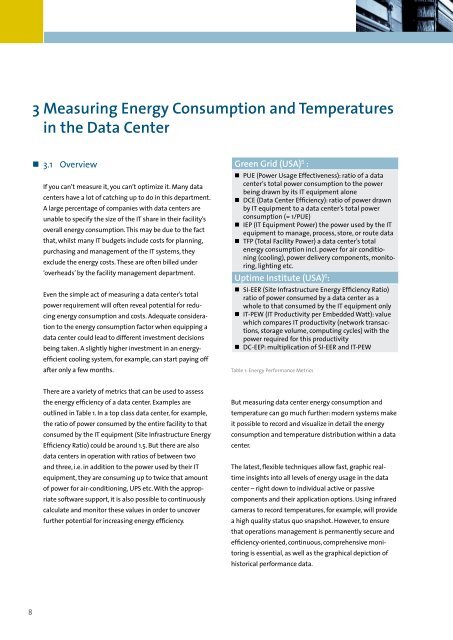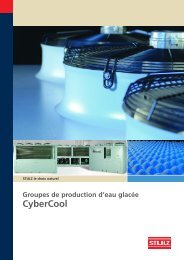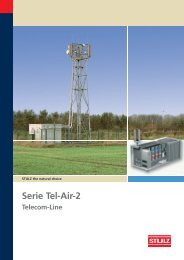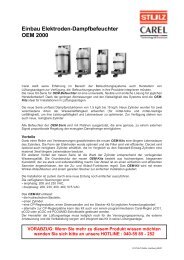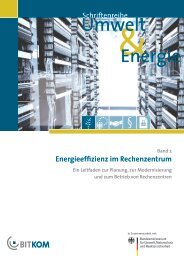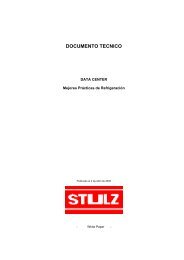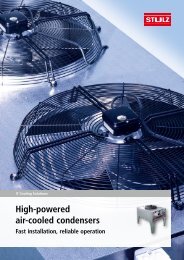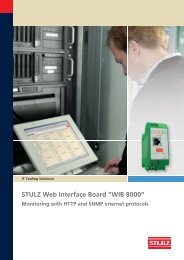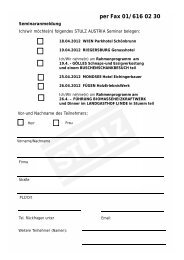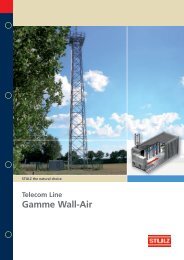Climate protection needs energy efficient data centers - Stulz GmbH
Climate protection needs energy efficient data centers - Stulz GmbH
Climate protection needs energy efficient data centers - Stulz GmbH
You also want an ePaper? Increase the reach of your titles
YUMPU automatically turns print PDFs into web optimized ePapers that Google loves.
3 Measuring Energy Consumption and Temperaturesin the Data Center• 3.1 OverviewIf you can’t measure it, you can’t optimize it. Many <strong>data</strong><strong>centers</strong> have a lot of catching up to do in this department.A large percentage of companies with <strong>data</strong> <strong>centers</strong> areunable to specify the size of the IT share in their facility’soverall <strong>energy</strong> consumption. This may be due to the factthat, whilst many IT budgets include costs for planning,purchasing and management of the IT systems, theyexclude the <strong>energy</strong> costs. These are often billed under‘overheads’ by the facility management department.Even the simple act of measuring a <strong>data</strong> center’s totalpower requirement will often reveal potential for reducing<strong>energy</strong> consumption and costs. Adequate considerationto the <strong>energy</strong> consumption factor when equipping a<strong>data</strong> center could lead to different investment decisionsbeing taken. A slightly higher investment in an <strong>energy</strong><strong>efficient</strong>cooling system, for example, can start paying offafter only a few months.Green Grid (USA) 5 :• PUE (Power Usage Effectiveness): ratio of a <strong>data</strong>center‘s total power consumption to the powerbeing drawn by its IT equipment alone• DCE (Data Center Efficiency): ratio of power drawnby IT equipment to a <strong>data</strong> center’s total powerconsumption (= 1/PUE)• IEP (IT Equipment Power) the power used by the ITequipment to manage, process, store, or route <strong>data</strong>• TFP (Total Facility Power) a <strong>data</strong> center’s total<strong>energy</strong> consumption incl. power for air conditioning(cooling), power delivery components, monitoring,lighting etc.Uptime Institute (USA) 6 :• SI-EER (Site Infrastructure Energy Efficiency Ratio)ratio of power consumed by a <strong>data</strong> center as awhole to that consumed by the IT equipment only• IT-PEW (IT Productivity per Embedded Watt): valuewhich compares IT productivity (network transactions,storage volume, computing cycles) with thepower required for this productivity• DC-EEP: multiplication of SI-EER and IT-PEWTable 1: Energy Performance MetricsThere are a variety of metrics that can be used to assessthe <strong>energy</strong> efficiency of a <strong>data</strong> center. Examples areoutlined in Table 1. In a top class <strong>data</strong> center, for example,the ratio of power consumed by the entire facility to thatconsumed by the IT equipment (Site Infrastructure EnergyEfficiency Ratio) could be around 1.5. But there are also<strong>data</strong> <strong>centers</strong> in operation with ratios of between twoand three, i.e. in addition to the power used by their ITequipment, they are consuming up to twice that amountof power for air-conditioning, UPS etc. With the appropriatesoftware support, it is also possible to continuouslycalculate and monitor these values in order to uncoverfurther potential for increasing <strong>energy</strong> efficiency.But measuring <strong>data</strong> center <strong>energy</strong> consumption andtemperature can go much further: modern systems makeit possible to record and visualize in detail the <strong>energy</strong>consumption and temperature distribution within a <strong>data</strong>center.The latest, flexible techniques allow fast, graphic realtimeinsights into all levels of <strong>energy</strong> usage in the <strong>data</strong>center – right down to individual active or passivecomponents and their application options. Using infraredcameras to record temperatures, for example, will providea high quality status quo snapshot. However, to ensurethat operations management is permanently secure andefficiency-oriented, continuous, comprehensive monitoringis essential, as well as the graphical depiction ofhistorical performance <strong>data</strong>.8


